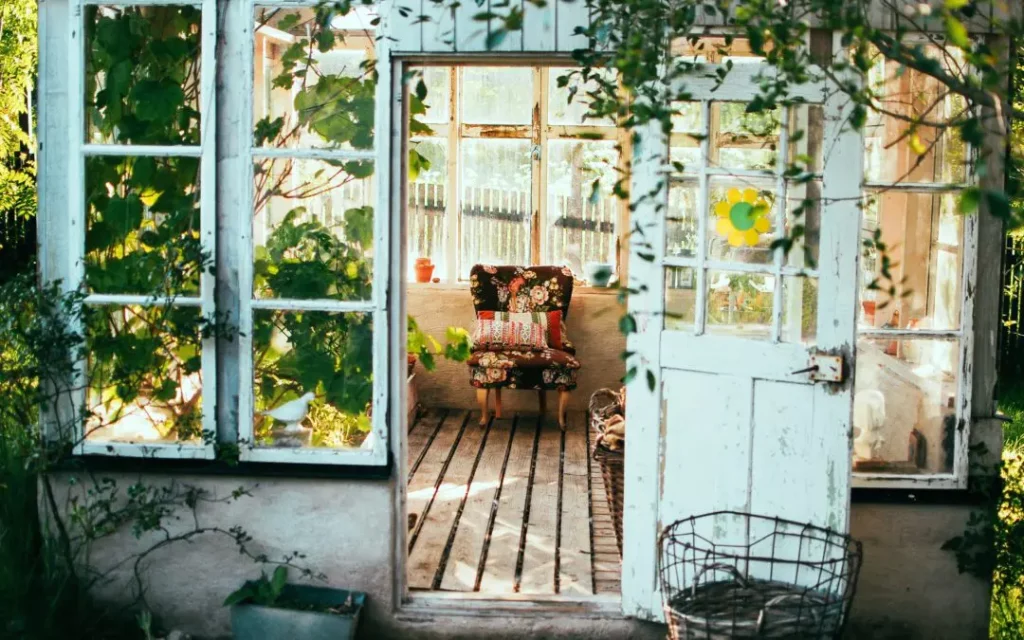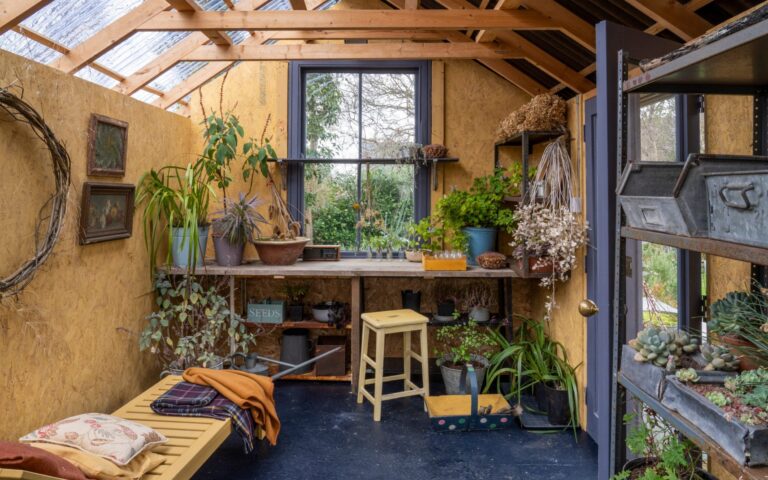One sunny day in my backyard, I looked at my old shed. It had been a storage space for a long time. I really like gardening, and I’ve always dreamed of having a greenhouse. Growing veggies all year and exotic plants sounded too good to pass up.
I decided to give it a try and change my shed into a greenhouse. It not only fulfilled my gardening dreams but also became a fun adventure.
In this article, I’m excited to tell you how I turned that old shed into a beautiful green place.
To turn a shed into a greenhouse follow these quick methods :
- Assess your shed’s condition and location.
- Choose a sunny location with southern exposure.
- Clear out the shed and clean it.
- Insulate and ventilate for temperature control.
- Install a suitable foundation.
- Weatherproof the shed and improve light penetration.
- Create planting beds with proper drainage.
- Add supplemental lighting if needed.
- Install shelves for storage and organization.
- Choose the right glazing material.
- Set up a heating system for temperature control.
- Install a watering system for efficient irrigation.
- Organize plants based on their needs.
- Regularly monitor and maintain the greenhouse.
How Can You Assess Your Shed for Greenhouse Conversion?

Before embarking on the exciting transformation of your shed into a greenhouse oasis, it’s crucial to assess its suitability and readiness for the conversion.
Evaluating the Shed’s Condition
Begin by thoroughly inspecting your shed’s structural integrity. Check for any signs of damage, such as rotting wood, rusted metal, or weakened supports. Address any structural issues before proceeding.
Furthermore, examine the roof to ensure it is in good condition. If it leaks or is damaged, it may need repair or replacement. Look for signs of pests, like termites or rodents, which can compromise the greenhouse environment and your plants.
Moreover, assess the shed’s overall size and layout. Ensure it provides sufficient space for your desired greenhouse activities, including plant beds and equipment storage.
Selecting an Appropriate Location
Choose the location for your converted shed with care. It should receive ample sunlight throughout the day, ideally with southern exposure, to provide the necessary light for plant growth. Consider factors like the shed’s proximity to water sources for irrigation and electricity for heating and lighting.
Moreover, evaluate the landscape around the shed. Ensure there are no obstructions like tall trees or buildings that might shade the greenhouse area.
Additionally, think about the convenience of access. You’ll need to enter and exit the greenhouse regularly for maintenance and harvesting, so the location should be easily accessible.
How to Prepare the Shed for Greenhouse Transformation?
Preparing your shed for its greenhouse transformation involves a series of essential steps to ensure a successful and flourishing indoor garden space.
Clearing the Shed and Cleaning It
Remove all items stored in the shed, including tools, equipment, and debris. Clearing the space will give you a clean slate to work with.
Moreover, thoroughly clean the shed to remove dirt, dust, and any existing plant material. This cleaning helps prevent pests and diseases from infiltrating your greenhouse. In addition, consider repainting the interior walls and ceiling with a light-colored, reflective paint to maximize light distribution inside the greenhouse.
Insulating and Ventilating for Temperature Control
Depending on your climate, insulation may be necessary to maintain a stable temperature. Use insulation materials appropriate for your region, such as fiberglass, foam board, or bubble wrap.
Moreover, proper ventilation is crucial to prevent overheating, especially during the summer. Install vents and louvers to allow hot air to escape and fresh air to enter. Automated vent systems can help regulate temperature.
Consider adding a thermostat-controlled fan or exhaust system to further enhance ventilation and temperature control.
Creating a Suitable Foundation
A solid foundation is essential to prevent moisture from seeping into the greenhouse. Common options include concrete slabs, pavers, or gravel. Choose the one that suits your budget and climate. Ensure the foundation is level to provide stability for shelving units and planting beds.
However, if your shed has a wooden floor, consider protecting it from moisture by applying a waterproof sealant or using a moisture-resistant barrier before installing your greenhouse components.
What Are Key Considerations for Weatherproofing and Lighting?
When weatherproofing and optimizing lighting for your shed-turned-greenhouse, prioritizing these key considerations is paramount to the growth and protection of your plants.
Sealing Gaps and Improving Light Penetration
Carefully inspect your shed for any gaps or cracks that may allow drafts, pests, or moisture to enter. Seal these gaps with weatherstripping, caulk, or appropriate sealants.
Enhance light penetration by cleaning and, if necessary, replacing windows and doors. Consider installing double-glazed or UV-resistant materials to maximize the amount of sunlight entering the greenhouse.
Moreover, ensure that windows and doors have a proper seal when closed to maintain temperature and humidity levels.
Choosing the Right Glazing Material
The choice of glazing material depends on your climate and budget. Options include:
- Glass: Provides excellent insulation and durability but can be expensive.
- Polycarbonate panels: Offers good insulation and diffuses light, reducing the risk of plants getting sunburned.
- Greenhouse plastic film: Economical, easy to install, and provides diffused light. However, it may require replacement over time.
Select the glazing material that best suits your greenhouse’s needs and climate conditions.
Installing Supplemental Lighting if Necessary
Assess the natural light conditions in your location, especially during the winter months when daylight hours are shorter.
However, if natural light is insufficient, install supplemental lighting. LED grow lights are energy-efficient and come in various spectra suitable for different growth stages of plants.
Position the supplemental lights strategically to ensure even light distribution throughout the greenhouse.
How to Optimize the Interior Setup for Your Greenhouse?
To create an optimal interior setup for your greenhouse, you’ll need to focus on factors such as layout, ventilation, and shelving, all of which play crucial roles in fostering a thriving plant environment.
Building Planting Beds or Shelving Units
Decide whether you want to use planting beds or shelves to grow your plants. Raised beds allow for direct planting in soil while shelving units provide space for containers or trays.
Build or install these features with durability and stability in mind. Use materials like pressure-treated lumber, cedar, or corrosion-resistant metal for longevity.
Moreover, ensure that the height and spacing of shelves or beds accommodate the types of plants you intend to grow.
Ensuring Proper Drainage
Proper drainage is essential to prevent waterlogging, which can harm plant roots. Use well-draining soil in planting beds and containers.
In addition, install a drainage system such as gravel or perforated pipes beneath the planting beds to redirect excess water away from the plants. Moreover, regularly check that drains are not clogged and that water flows freely.
Adding Shelves for Storage and Organization
Besides shelving for plants, consider adding additional shelves or storage units for gardening tools, pots, and supplies. Moreover, organize your tools and supplies in a way that makes them easily accessible. Hooks, pegboards, and storage bins can help keep everything tidy.
Label and categorize items to streamline your gardening activities and maintain an organized space.
How Can You Achieve Effective Temperature and Humidity Control?

Achieving effective temperature and humidity control in your greenhouse is essential for providing the ideal environment for plant growth.
Installing Heating Systems
Depending on your climate and the types of plants you intend to grow, you may need to install heating systems. Common options include:
- Electric heaters: Efficient and easy to control.
- Propane or natural gas heaters: Suitable for larger greenhouses but require proper ventilation.
- Radiant floor heating: Provides even heat distribution, preventing cold spots.
Position heaters strategically to ensure consistent temperature throughout the greenhouse.
Monitoring and Maintaining Temperature
Use a reliable thermometer or thermostat to monitor the temperature within your greenhouse. Place it at plant height for accurate readings.
Set temperature thresholds based on the specific needs of your plants. Keep a close eye on temperature fluctuations, especially during extreme weather conditions.
Moreover, implement automated systems to control heating and cooling, such as fans, vents, and curtains, based on temperature sensors.
Implementing a Watering System for Irrigation
Install a watering system that suits your greenhouse’s size and the types of plants you’re cultivating. Options include drip irrigation, soaker hoses, or automated sprinkler systems.
Ensure that the watering system provides consistent moisture to the plants while preventing overwatering or waterlogged soil.
In addition, use timers and moisture sensors to automate watering routines, adjusting them as needed based on plant requirements and seasonal changes.
What’s the Best Maintenance and Care Routine for Your Greenhouse?
The best practices for nurturing your plants and ensuring the longevity of your transformed shed.
Regularly Checking for Pests and Diseases
Inspect your plants frequently for signs of pests, such as discolored leaves, webs, or unusual growth patterns. Implement integrated pest management (IPM) techniques, including biological controls, organic pesticides, and handpicking, to manage pest infestations.
Moreover, quarantine new plants before introducing them to the greenhouse to prevent the spread of pests and diseases.
Maintaining Proper Humidity and Ventilation
Monitor humidity levels and ensure they are within the optimal range for your plants. Use humidifiers or dehumidifiers as needed. Proper ventilation is crucial for maintaining healthy humidity levels and preventing fungal issues. Ensure vents and fans are functioning correctly.
In addition, regularly clean and sterilize equipment and surfaces to reduce the risk of mold and pathogens.
Keeping an Eye on Overall Plant Health
Conduct routine inspections of your plants, looking for signs of stress, nutrient deficiencies, or irregular growth. Moreover, maintain a proper fertilization schedule based on the needs of your plants.
Adjust nutrient levels as indicated by soil tests or plant symptoms. Prune and train plants as necessary to encourage healthy growth and maximize space utilization.
FAQ’s
Can you turn a plastic shed into a greenhouse?
Yes, you can convert a plastic shed into a greenhouse by adding appropriate glazing, insulation, and ventilation to create a suitable environment for plants.
Can you turn a building into a greenhouse?
Yes, it’s possible to convert a building into a greenhouse with the right modifications, including installing proper glazing, temperature control systems, and plant beds.
How to make a cheap greenhouse?
You can make a cheap greenhouse by using materials like PVC pipes, greenhouse plastic film, and repurposed windows or doors. DIY designs and simple structures can save costs.
Does greenhouse plastic hold heat?
Greenhouse plastic is designed to trap heat and create a warm environment for plants. It acts as a greenhouse effect, allowing sunlight in and preventing heat from escaping.
Do plastic greenhouses stay warm?
Plastic greenhouses can stay warm when properly insulated and equipped with adequate heating systems. Proper sealing and ventilation are also important for temperature control.
Do plastic greenhouses need ventilation?
Yes, plastic greenhouses need ventilation to prevent overheating, maintain the right humidity levels, and ensure proper air circulation for plant health.
Will any plastic work for a greenhouse?
Not all types of plastic are suitable for greenhouses. Greenhouse-grade plastic is designed to allow light transmission while retaining heat. It’s essential to use the right type of plastic for this purpose.
Conclusion
In summary, embarking on the journey to transform a shed into a greenhouse has been a rewarding endeavor. Through careful assessment and preparation, I’ve ensured that my greenhouse not only shelters my plants but also creates an environment where they can thrive.
The meticulous weatherproofing, choice of glazing materials, and the addition of supplemental lighting have turned my shed into a sanctuary for green life. Inside, the interior setup with thoughtfully built planting beds, efficient drainage, and well-organized storage shelves has made gardening a joy.
Furthermore, temperature and humidity control systems have empowered me to tailor the greenhouse environment to my plants’ needs, while the strategic organization of different plant varieties ensures that each one flourishes in its ideal microclimate.

